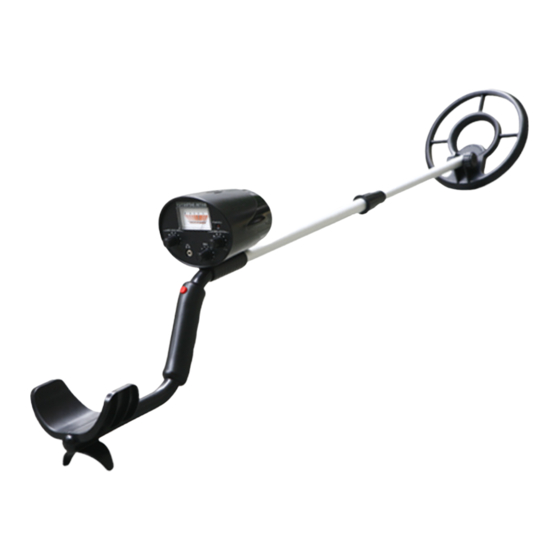
Subscribe to Our Youtube Channel
Summary of Contents for Treasure Cove Hobbyist TC-1006
- Page 1 Treasure Cove Metal Detector The Hobbyist TC-1006 OWNER’S MANUAL (Revised October 3, 2012) www.Treasure-Cove.com 805-288-5735...
-
Page 2: Installing The Detector
FEATURE With your metal detector, you can hunt for coins, relics, jewelry, gold, and silver just about anywhere. The detector is versatile and easy to use. The detector’s features include: Headphone Jack—let you connect head phones (not supplied) and operate without trouble. View Meter and Pointer—shows the probable type of me tal being detected . -
Page 3: Installing Batteries
Then turn the stem’s lock nut counter clockwise to lock it in place. Note: No need to loosen the stem lock completely, or the plastic ring inside may easily fall out and got lost. If the insi de ring falls out, please put it back and then tighten the lock set. -
Page 4: Using Headphone
Slide the battery cover off in the direction of the arrow. Insert the battery into the compartm ent as indicated by the p olarity symbols (+ and -) marked inside the compartment. And then re place the cover. Cautions: Always remove old or weak batteri es, which can leak chemicals that can destroy electronic parts. -
Page 5: Operation
headphone jack on the side of the control h ousing. The detector’s internal speaker disconnects when you connect the headphone. Listening Safely Do not listen at extremely high vo lume levels. Extended high volume listening can lead to permanent hearing loss. Do not wear earph ones while operating yo ur detector nea r high-traffic areas... -
Page 6: Using The Detector
Press the red button on the handle at any time during operatio n Note: and the pointer will return to 0 automatically. 3.USING THE DETECTOR Remove watches, rings, or other metal jewelry you are wearing Holding the search coil level a nd about 1/2-2 inches abo ve the ground. -
Page 7: Testing And Using The Detector
At "0" the detector may still make a sound. When detecting ferrous metal, detector will give out a lower voice as the pointer moves to the left , possibly silencing when all the way left. When detector finds non-ferrous metal, it will make a louder voice while the pointer moves to the right. - Page 8 Move a sample of the material y ou want the detector to find (such as a gold ring or a coin) about 5 cm above the search coil. If the detector detects the material, the pointer moves to the lef t (ferrous) with its sound down or t o the right (non-ferrous) with it s sound up while the det ector determines the typ e of meal it is detecting.
- Page 9 the sample, sweeping the search coil in a side-to-side motion. Before try finding other metal in the area press the red button to return the pointer to the center of the view meter. Search Coil Sweeping Hints: Never sweep the search coil as if it were a pe ndulum. Raising the search coil while sweeping or at the end of a sweep cause s false readings.
- Page 10 metal. The detector’s DISCRIMINATION setting d etermines whether the detector will distingu ish between different types of ferrous and non-ferrous metals. You can set DISCRIMIN ATION to mi nimum (fully counterclockwise), with rotating clockwise, the detecto r first discriminates iron, then pull tabs and nickel.
-
Page 11: Pinpointing A Target
things: the angle at which the ob ject rests in the ground, the depth of the object, the amount of iron in the object, the size of the object. 4. PINPOINTING A TARGET Accurately pinpointing a target makes digging it up easier . However, it needs practice to improve this skill, and we suggest you practice finding and digging up small met al objects on your ow n property before yo u search other locations. -
Page 12: Troubleshooting
Notes: If trash in an area is so heavy that you get false signals, slow your sweep speed and use shorter sweeps. Recently buried coins might not respond the same as coins b uried for a long period of time because of oxidation. Some nails, nut s, bolts, and other iron objects (such as old bottle caps) oxidize and create a “halo”... -
Page 13: Care And Maintenance
The detector might sound a false signal if it detects heavily oxi dized metals. Try pinpointing the target from several different angles (see “Pinpointing a Target”). If the detector does not display and sou nd the same signal each time, th target probably heavily oxidized metal. - Page 14 Temperature extremes can shorten the life of electronic device s, damage the cases of the detector. Wipe the detector with a damp cloth occasionally to keep it looking new. Do not use harsh chem icals, cleaning solvents, or stron g detergents to clean the detector.
















Need help?
Do you have a question about the Hobbyist TC-1006 and is the answer not in the manual?
Questions and answers